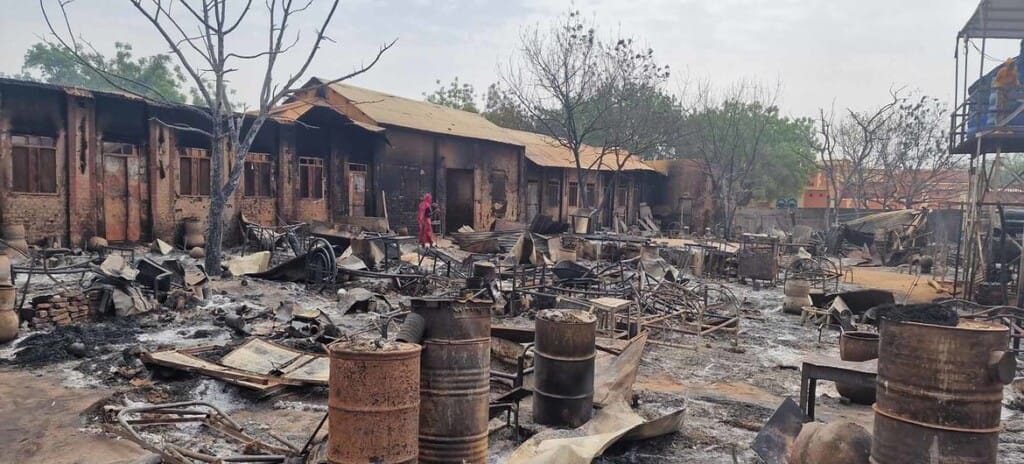An Absence of Learning
The Universal Declaration of Human Rights states that the right to education is legally binding on the state, while the Convention on the Rights of the Child guarantees the right of education for all children. However, the vacuum of learning resulting from conflict affects millions of children and young adults in war-torn areas across the globe.
In Sudan, over 19 million children are currently out of school, which experts have defined as a whole generation denied their education. “UNICEF has confirmed that Sudan is now the location of the largest child displacement crisis in the world and that this means an entire generation of children will be deprived of their right to education.”1 In Palestine, ‘scholasticide’, a term coined in 2009, refers to a pattern of attacks on “Palestinian scholars, students, and educational institutions going back to the Nakba of 1948”.2
Recently, human rights experts at the UN have condemned the ‘callous’ and systematic attacks on the educational infrastructure in Gaza, noting that 80 percent of schools have been damaged or destroyed. All levels of education have been destroyed including all 12 universities.3
A generation of lost education can be devastating at the individual, community, national and international levels. It leads into a cycle of poverty and underdevelopment, with societies experiencing higher levels of crime, social conflict, marginalisation and lawlessness. 4
Conflict and Trauma Today
Combined with with ongoing and violent conflict, displacement, hunger, sexual abuse, trafficking and disease, this generation of children have been subjected to traumas in ways most adults cannot even fathom. Whether it’s Sudan, Gaza, or Myanmar, where children have lost more than three years of schooling5, or the DRC where 2,100 schools have been shut down due to violence6, or other conflicts no longer on headline news such as in Yemen and Syria, what happens when the conflict is over? There will be very few options to return to; indeed the Ministry of Education in Sudan has tried to reopen schools, but how to do that when consistently under the threat of violence? Children are displaced, the infrastructure destroyed, schools looted of resources. Teachers are scattered. 7

A school that served as a shelter for new displaced in El Geneina was torched, May 27 (Mohamed Khalil / UNHCR)
And while attempts to begin re-educating children are happening in these zones of war, most children spend their days searching for food and water. “Seven months of war have taught them survival skills, not grammar and algebra”. 8
What happens when they go back to school? How will they make space for learning again when they have spent so much time in survival mode? And what can we do as educators to ensure that students receive the informed learning that they so desperately deserve once they are back in the classroom?

“School-aged children are paying an unacceptable price for the growing conflict and insecurity in eastern DRC,” said UNICEF representative Grant Leaity.9
How Childhood Trauma Affects the Brain

Research has shown that childhood trauma can alter the structure of the young brain. The hippocampus, which affects learning, memory and spatial relationships and in the prefrontal cortex is where attention, emotional regulation and problem-solving reside.10
This can often manifest in ways which unfortunately, educators can associate with ‘troublesome’ behaviour. Children can often be dismissed as unwilling to learn, or just fall under the radar as educators fail to recognise the trauma. This can lead to students feeling unseen, unimportant, as they carry a burden silently and in the dark.
Informed Classroom Practices and Staying in School
Teaching in a trauma-informed classroom means that the approach is informed of the trauma and its impact on students affected. This includes understanding that the emotional and physical behaviours of students will often be marred by the distressing experiences. This might look like a lack of engagement, disinterest, fatigue, verbal outbursts and lack of cooperation. Students may display signs of test anxiety or inability to concentrate. They may avoid classmates and teachers. Low academic achievement and a lack of motivation are some of the other outcomes of possible trauma11. Here is where educators can respond in ways that promote an ongoing cycle of understanding, safety and trust, through the development of trauma-informed positive relationships. Ultimately, we want students to STAY IN SCHOOL.
An informed classroom needs to be safe, with consistency and nurturing. A place where students can feel seen and heard. Feelings of shame and marginalisation from war trauma can often make students feel silenced, unimportant and unheard. Validating their experiences can bring them back into the light. It is important to remember that students may still have family and loved ones in conflict zones. They likely had to leave behind their possessions, pets and childhood homes. Often their homes themselves have been destroyed and sadly, they may have even lost loved ones in the conflict. Possible course content relating to loss, violence, or refugees, among other topics, can be triggering to students.
Educators and counsellors can be available to students to answer questions and meet their needs. For example, giving them agency to ask for help or take action perhaps by raising awareness of their plight at a school assembly, or organising a humanitarian relief drive. 12
What Else Can We Do?
It is imperative not to assume the source or extent of the trauma or compare the trauma to other events, and that we aim to put aside any possible personal political, cultural or religious biases.
We should also not presume we know who is affected by trauma. For example, in the international school system, a conflict in Sudan does not mean only people that are Sudanese have been affected.
All over the world international families are living in war torn countries so it’s best for schools to make sure they don’t just look for nationality, but from which school students are from.
Counsellors, teachers and even admin staff can support students by not taking behaviour personally. Teachers may think ‘why is this student falling asleep in my classroom’ and associate it with apathy, while in reality the student suffered a sleepless night filled with nightmares and traumatic memories. Ongoing, non-judgemental communication amongst one another is therefore extremely important.
Informed practices in educational institutions can help ease students’ trauma responses in the classroom and improve their future prospects . Educating ourselves about conflict wherever it may be, and providing the resources to inform our practices is the first step we can take in ensuring a generation of children are not deprived of their right to learn.
- Sudan: Education Lost for a Generation ↩︎
- Scholasticide Definition Scholasticide is a term that was first coined by Professor Karma Nabulsi, an Oxford don and Palestinian ↩︎
- Scholasticide Definition Scholasticide is a term that was first coined by Professor Karma Nabulsi, an Oxford don and Palestinian ↩︎
- The problem of illiteracy — Teach the World Foundation ↩︎
- A generation of children are at risk of learning losses in Myanmar ↩︎
- Conflict in eastern DRC is having a devastating impact on children’s education ↩︎
- Sudan schools to re-open as displaced shelters face uncertain future – Dabanga Radio TV Online ↩︎
- With Schools in Ruins, Education in Gaza Will Be Hobbled for Years – The New York Times ↩︎
- Conflict forces more than 2,000 schools to close in eastern DR Congo: UN ↩︎
- How Does Childhood Trauma Affect Learning and Education? ↩︎
- How Does Childhood Trauma Affect Learning and Education? ↩︎
- Communicating Conflict: How to address war and create a safe space in the classroom – Resource hub for schools and districts
↩︎



